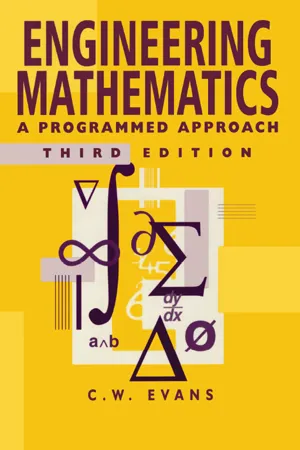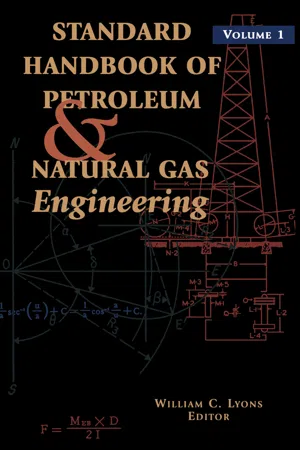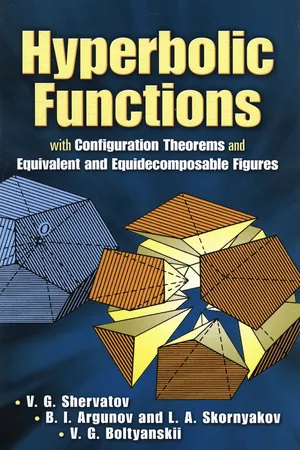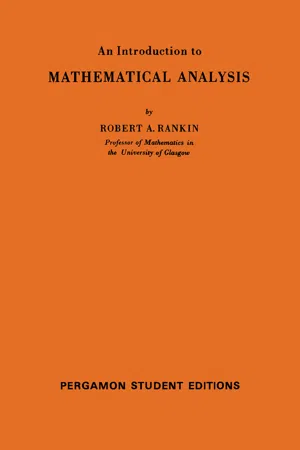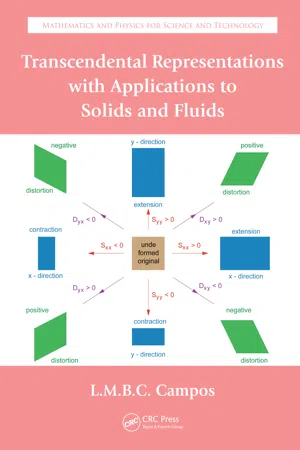Mathematics
Hyperbolic Functions
Hyperbolic functions are analogs of trigonometric functions, defined in terms of the hyperbola rather than the circle. The main hyperbolic functions are the hyperbolic sine, hyperbolic cosine, and hyperbolic tangent. They have applications in various areas of mathematics and physics, particularly in the study of curves and surfaces.
Written by Perlego with AI-assistance
Related key terms
1 of 5
10 Key excerpts on "Hyperbolic Functions"
- eBook - ePub
Engineering Mathematics
A Programmed Approach, 3th Edition
- C W. Evans, C. Evans(Authors)
- 2019(Publication Date)
- Routledge(Publisher)
Hyperbolic Functions 5Although we have now explored some of the basic terminology of mathematics and developed the techniques of the differential calculus, we need to pause to extend our algebraic knowledge. In this chapter we shall describe a class of functions known as the Hyperbolic Functions which are very similar in some ways to the circular functions. We shall use the opportunity to consider in detail what is meant by an inverse function.After studying this chapter you should be able to □ Use the Hyperbolic Functions and their identities; □ Solve algebraic equations which involve Hyperbolic Functions; □ Differentiate Hyperbolic Functions; □ Decide when a function has an inverse function; □ Express inverse Hyperbolic Functions in logarithmic form. We shall also consider a practical problem concerning the sag of a chain. 5.1 DEFINITIONS AND IDENTITIESThe Hyperbolic Functions are in some ways very similar to the circular functions. Indeed when we deal with complex numbers (Chapter 10 ) we shall see that there is an algebraic relationship between the two. Initially we shall discuss the Hyperbolic Functions algebraically, but later we shall see that one of them arises in a physical context.The functions cosine and sine are called circular functions because x = cos θ and y = sin θ satisfy the equation x2 + y2 = 1, which is the equation of a circle. The functions known as the hyperbolic cosine (cosh) and the hyperbolic sine (sinh) are called Hyperbolic Functions because x = cosh u and y = sinh u satisfy the equation x2 – y2 = 1, which is the equation of a rectangular hyperbola.We shall define the Hyperbolic Functions and use these definitions to sketch their graphs. Here then are the definitions: - William C. Lyons(Author)
- 1996(Publication Date)
- Gulf Professional Publishing(Publisher)
Graphs of the trigonometric functions. Trigonometry 33 Hyperbolic Functions The hyperbolic sine, hyperbolic cosine, etc. of any number x are functions related to the exponential function e x. Their definitions and properties are very similar to the trigonometric functions and are given in Table 1-5. The inverse Hyperbolic Functions, sinh-~x, etc., are related to the logarithmic functions and are particularly useful in integral calculus. These relationships may be defined for real numbers x and y as sinh-' (x/y) = ln(x + ~/x 2 + y2 )_ In y cosh-' (x/y) = ln(x + ~x 2 - y2 ) _ In y tanh-'(x/y) = 1/2 9 ln[(y + x)/(y - x)] coth-'(x/y) = 1/2 9 ln[(x + y)/(x- y)] Table 1-5 Hyperbolic Functions sinh x = 1/2(e x- e -') cosh x = 1/2(e x + e -') tanh x = sinh x/cosh x csch x = 1/sinh x sech x = 1/cosh x coth x = 1/tanh x sinh(-x) =-sinh x cosh(-x) = cosh x tanh(-x) = -tanh x cosh2x - sinh2x = 1 1 - tanh2x = sech2x 1 - coth2x = - csch2x sinh(x :1: y) = sinh x cosh y + cosh x sinh y cosh(x :1: y) = cosh x cosh y • sinh x sinh y tanh(x _+ y) = (tanh x __ tanh y)/(1 + tanh x tanh y) sinh 2x = 2 sinh x cosh x cosh 2x = cosh2x + sinh2x tanh 2x = (2 tanh x)/(1 + tanh2x) sinh(x/2) = ~ij/2(cosh x - I1) cosh(x/2) = ~i/2(cosh x + 1) tanh(x/2) = (cosh x- 1)/(sinh x) = (sinh x)/(cosh x + 1) 34 Mathematics Polar Coordinate System The polar coordinate system describes the location of a point (denoted as [r,0]) in a plane by specifying a distance r and an angle 0 from the origin of the system. There are several relationships between polar and rectangular coordinates, diagrammed in Figure 1-30. From the Pythagorean Theorem r = _+~x 2 + y2 Also sin 0=y/r or y-- r sin 0 cos 0=x/r or x=rcos0 tan 0 = y/x or 0 = tan-'(y/x) To convert rectangular coordinates to polar coordinates, given the point (x,y), using the Pythagorean Theorem and the preceding equations.- eBook - ePub
- Seymour B. Elk(Author)
- 2016(Publication Date)
- Bentham Science Publishers(Publisher)
radians.At this point, the reader (be they the instructor or an astute student who has been exposed to this material before) should be aware that a very different, both mathematical and philosophical, approach to the development of hyperbolic trigonometry has been selected. In direct contradistinction to the traditional “analysis” prospectus, which defined these terms as the following combination of exponential functions (ex and e−x ):the six important hyperbolic trig functions are viewed as emanating from the relevant “geometry”. In other words, this treatise does not follow the vast majority, if not all of the other, of the calculus books that are (or were) in circulation [14- 21], in that the others have chosen the above set as the definitions for the Hyperbolic Functions.To the contrary, this author regards the above presently championed set of definitions as serendipity, much as a magician drawing rabbits out of a hat. This is especially true since he feels that the salient feature of the hyperbolic trig functions is (AND SHOULD BE) their association with the unit hyperbola, rather than some (admitted true but) secondary relation to the domain of exponential functions. In other words, in the same manner as the coordinating effect of re-defining the circular trig functions using the unit circle (rather than the ratio of sides in a right triangle) proved valuable in extending the domain of trigonometry from its being limited to from 0 to 180 degrees (or alternately from 0 to π radians) to the entire domain of real numbers. A similar further extension of the domain of definition from the set of real numbers to the set of complex numbers is one of the advantages of such a redefinition. In Chapter 7 it will be demonstrated that both methods of definition lead to the same mathematical development. - eBook - ePub
Hyperbolic Functions
with Configuration Theorems and Equivalent and Equidecomposable Figures
- V. G. Shervatov, B. I. Argunov, L. A. Skornyakov, V. G. Boltyanskii(Authors)
- 2013(Publication Date)
- Dover Publications(Publisher)
Hyperbolic Functions
V. G. ShervatovPREFACE TO THE AMERICAN EDITION
IN THIS BOOKLET the hyperbolic sine, hyperbolic cosine, and hyperbolic tangent are introduced in connection with the geometric properties of the hyperbola, and the fundamental properties of these functions are derived. Natural logarithms are then discussed.With the aid of complex numbers, basic formulas are derived which interrelate Hyperbolic Functions, trigonometric functions, and the number e . Finally, infinite series expansions of sinh t , cosh t , sin t , cos t , andeaare given.Two years of high school algebra and an acquaintance with trigonometry are sufficient to enable the reader to understand Chapters 1 and 2 . To understand fully the last chapter it is necessary to have some acquaintance with the theory of limits. However, those who do not possess this background will be able to follow much of the discussion.Passage contains an image
CONTENTS
CHAPTER 1. The Hyperbolic Rotation1. Homothetic transformations2. Strains3. The hyperbola4. The hyperbolic rotation5. Properties of the hyperbolaCHAPTER 2. Hyperbolic Functions6. The unit hyperbola and its equation7. The Hyperbolic Functions8. Identities between Hyperbolic FunctionsCHAPTER 3. Natural Logarithms9. Logarithms and the hyperbola10. The base e of natural logarithms11. Analytic expressions for the Hyperbolic Functions12. Infinite series expansions for e a , sinh t , cosh t13. Euler’s formulasPassage contains an image
1. The Hyperbolic Rotation
1. HOMOTHETIC TRANSFORMATIONSIn solving problems in geometry we often use the following type of transformation. Pick a point O in the plane and a positive number k . If A is any other point, let us transform the point A into the point A ′ such that A ′ lies on the half-line OA and (Fig. 1a, b ). We leave the point O fixed by the transformation. Such a transformation is called a homothetic transformation , O is called the homothetic center (or center of similitude ), and k is called the homothetic ratio (or ratio of similitude ). Obviously, if k < 1, then OA ′ < OA (Fig. 1a), while if k > 1, then OA ′ > OA (Fig. 1b - No longer available |Learn more
- (Author)
- 2014(Publication Date)
- Learning Press(Publisher)
________________________ WORLD TECHNOLOGIES ________________________ Chapter 6 Hyperbolic Function & Trigonometric Functions Hyperbolic function A ray through the origin intercepts the hyperbola in the point , where is twice the area between the ray and the -axis. For points on the hyperbola below the -axis, the area is considered negative . ________________________ WORLD TECHNOLOGIES ________________________ In mathematics, Hyperbolic Functions are analogs of the ordinary trigonometric, or circular, functions. The inverse Hyperbolic Functions are the area hyperbolic sine arsinh (also called asinh, or sometimes by the misnomer of arcsinh) and so on. Just as the points (cos t , sin t ) form a circle with a unit radius, the points (cosh t , sinh t ) form the right half of the equilateral hyperbola. Hyperbolic Functions occur in the solutions of some important linear differential equations, for example the equation defining a catenary, and Laplace's equation in Cartesian coordinates. The latter is important in many areas of physics, including electromagnetic theory, heat transfer, fluid dynamics, and special relativity. The Hyperbolic Functions take real values for a real argument called a hyperbolic angle. In complex analysis, they are simply rational functions of exponentials, and so are meromorphic. Hyperbolic Functions were introduced in the 1760s independently by Vincenzo Riccati and Johann Heinrich Lambert. Riccati used Sc. and Cc. ( [co]sinus circulare ) to refer to circular functions and Sh. and Ch. ( [co]sinus hyperbolico ) to refer to Hyperbolic Functions. Lambert adopted the names but altered the abbreviations to what they are today. Standard algebraic expressions sinh, cosh and tanh ________________________ WORLD TECHNOLOGIES ________________________ csch, sech and coth The Hyperbolic Functions are: • Hyperbolic sine: • Hyperbolic cosine: • Hyperbolic tangent: • Hyperbolic cotangent: - eBook - PDF
Calculus
Late Transcendental
- Howard Anton, Irl C. Bivens, Stephen Davis(Authors)
- 2016(Publication Date)
- Wiley(Publisher)
400 Chapter 6 / Exponential, Logarithmic, and Inverse Trigonometric Functions HYPERBOLIC IDENTITIES The Hyperbolic Functions satisfy various identities that are similar to identities for trigono- metric functions. The most fundamental of these is cosh 2 x − sinh 2 x = 1 (1) which can be proved by writing cosh 2 x − sinh 2 x = (cosh x + sinh x)(cosh x − sinh x) = e x + e −x 2 + e x − e −x 2 e x + e −x 2 − e x − e −x 2 = e x · e −x = 1 Other hyperbolic identities can be derived in a similar manner or, alternatively, by per- forming algebraic operations on known identities. For example, if we divide (1) by cosh 2 x, we obtain 1 − tanh 2 x = sech 2 x and if we divide (1) by sinh 2 x, we obtain coth 2 x − 1 = csch 2 x The following theorem summarizes some of the more useful hyperbolic identities. The proofs of those not already obtained are left as exercises. 6.8.2 THEOREM cosh x + sinh x = e x sinh (x + y) = sinh x cosh y + cosh x sinh y cosh x − sinh x = e −x cosh (x + y) = cosh x cosh y + sinh x sinh y cosh 2 x − sinh 2 x = 1 sinh (x − y) = sinh x cosh y − cosh x sinh y 1 − tanh 2 x = sech 2 x cosh (x − y) = cosh x cosh y − sinh x sinh y coth 2 x − 1 = csch 2 x sinh 2x = 2 sinh x cosh x cosh (−x) = cosh x cosh 2x = cosh 2 x + sinh 2 x sinh (−x) = −sinh x cosh 2x = 2 sinh 2 x + 1 = 2 cosh 2 x − 1 WHY THEY ARE CALLED Hyperbolic Functions Recall that the parametric equations x = cos t, y = sin t (0 ≤ t ≤ 2π ) represent the unit circle x 2 + y 2 = 1 (Figure 6.8.3a), as may be seen by writing Figure 6.8.3 x 2 + y 2 = cos 2 t + sin 2 t = 1 If 0 ≤ t ≤ 2π , then the parameter t can be interpreted as the angle in radians from the positive x-axis to the point (cos t, sin t) or, alternatively, as twice the shaded area of the sector in Figure 6.8.3a (verify). - Gautam Bandyopadhyay(Author)
- 2023(Publication Date)
- CRC Press(Publisher)
H., Enter Stage Center: The Early Drama of the Hyperbolic Functions Mathematics Magazine, Vol. 77, No. 1, Feb, 2004, pp. 15 -30 Burn, B., Gregory of St. Vincent and the Rectangular Hyperbola The Mathematical Gazette, Vol. 84, No. 501., Nov., 2000, pp. 480-485. Mcmahon, J.,1906 Hyperbolic Functions 4th Edition Enlarged, John Wiley & Sons, New York, Chapman & Hall, London. Markushevich, A. I., 1966 The Remarkable sine functions American Elsevier Publishing Company Incorporated, New York Maor E., 1998 Trigonometric Delight Princeton University Press, New Jersey Kline M. Calculus-An Intuitive and Physical Approach 2nd Edition, Dover Publication Boyajian, A. Origin and Meaning of Circular and Hyperbolic Functions in Electrical Engineering Journal of Franklin Institute, Vol. 249, Issue 2, February 1950, pp. 117-131. Shervatov, V. G. 2007 Hyperbolic Functions Dover Publications Inc., Mineola, New York- eBook - ePub
- Alan Jeffrey(Author)
- 2004(Publication Date)
- Chapman and Hall/CRC(Publisher)
6Exponential, logarithmic and Hyperbolic Functions and an introduction to complex functions
The exponential function ex was introduced in Chapter 3 as an example of a function defined by a limit. Its occurrence throughout mathematics, together with its inverse, the natural logarithmic function ln x , is sufficiently frequent to justify studying ex and ln x separately. In the first part of this chapter the differentiability property of ex is established by means of a definition of the exponential function which is different than but equivalent to the one used in Chapter 3 and makes use of that definition together with a geometrical argument and the idea that a function can be defined in terms of a series involving powers of x. The differentiability properties of the natural logarithmic function are then deduced from those of the exponential function by using the fact that dy/ dx = 1/(dx /dy).The Hyperbolic Functions sinhx , cosh x and tanhx are all defined in terms of the exponential function, so it is natural that they should be introduced and their differentiability properties established immediately after an account of the exponential function. The chapter then considers the exponential function with a complex argument, and shows how by making use of the series representations for the sine and cosine functions it is possible to establish de Moivre’s theorem for any real x. The theorem is then used to show how various trigonometric identities can be deduced in a simple manner. The representation of functions as series involving powers of x , called power series, is taken up again and developed formally in Chapter 12 . Finally a brief introduction to complex functions is given to justify the replacement of x by ix in the series for ex - eBook - PDF
An Introduction to Mathematical Analysis
International Series of Monographs on Pure and Applied Mathematics
- Robert A. Rankin, I. N. Sneddon, S. Ulam, M. Stark(Authors)
- 2016(Publication Date)
- Pergamon(Publisher)
The properties of these four functions are easily deduced from those of sinhx and coshx. For example, we have THE0RElVI 25.3.1. The hyperbolic tangent function is defined on and is odd, strictly increasing, continuous and di#erentiable, its deri-vative at x being sech 2 x. For all x e . , -1 < tanhx < 1; tanhx > 1 as x -± oo, and tanhx ->- - 1 as x - oo. The hyperbolic tangent function defined on ., possesses a unique inverse function, called the inverse hyperbolic tangent function, which is defined o ~~ ]- 1, 1[. The value of this inverse function at a pointy 0/] -1, l[ is denoted by tanh -1 y. I f y = tanh x, where x e f , then x = tanh -1 y and y e]- 1, l[, and conversely. The inverse hyperbolic tangent function is odd, strictly increasing, continuous and differentiable on ]- 1, 1[, its derivative at y being d y tanh -ly= 1 l ye ( -1- 1 -, tanh -1 y oo; as y- -1+, tank -1 y --i -oo. Finally, tanh -1 y=;log 1 + ~ (-1 1) , sech -1 y = cosh -1 (1/y) (0 < y <= 1), cosech -1 y = sinh -1 (1/y) (y < 0, y >8) , the inverse functions {coth -1 y} , {sech -1 y} and {cosech -1 y} are defined on the domains indicated. The following alternative notations can be used: sh x for sinh x, ch x for cosh x , arc sinh x, arc sh x or sh -1 x for sinh -1 x, etc. EXERCISES 25 25.1. Prove Theorem 25.3.1. 25.2. Sketch roughly the graphs of the six Hyperbolic Functions and their inverse functions. 246 AN INTRODUCTION T O MATHEMATICAL ANALYSIS 25.3. Show that tanhiz = itanz, taniz = itanhiz, for all complex z for which they are defined. 25.4. Show that {(sinhx)/x} increases strictly on R 0 . 25.5. Show that c 2 —1 log x = tanh -1 x2 + 1 *25.6. If y2 z 1, express (x > 0). in terms of cosh -1 y. 25.7. Obtain formulae for tanh (x * y) in terms of tanh x and tanh y. 25.8. Show that, if tanh x = t, then sinh x = 1 2 t t2 , cosh x — 1 +t 2 2 25.9. - Luis Manuel Braga da Costa Campos(Author)
- 2012(Publication Date)
- CRC Press(Publisher)
337 Circular and Hyperbolic Functions that can also be obtained from previous results: (1) the formulas for squares of the circular (hyperbolic) cosine and sine coincide [Equations 5.82a and 5.82b ≡ Equations 5.61b and 5.61c (Equations 5.83a and 5.83b ≡ Equations 5.62b and 5.62c)] with the circular (hyperbolic) cosine of double variable; and (2) the latter (Equations 5.61a through 5.61c and 5.62a through 5.62c) and the circular (hyperbolic) sine of double variable [Equation 5.63a (Equation 5.63b)] appear in the cubes of the circular (hyperbolic) cosine [Equation 5.86a (Equation 5.87a)] and sine [Equation 5.86b (Equation 5.87b)]: cos cos cos ( ) cos cos( ) cos co 3 1 2 2 2 1 2 3 2 3 4 z z z z z z = + = + + = s cos ( ) z z + 1 4 3 , (5.86a) sin sin cos( ) sin sin ( ) sin si 3 1 2 2 2 1 2 3 2 3 4 z z z z z z = -= --= n sin ( ), z z -1 4 3 (5.86b) cosh cosh cosh cosh cosh cosh 3 2 1 2 1 2 1 2 3 z z z z z = ( ) + = + ( ) + z z z 2 3 4 1 4 3 = + ( ) cosh cosh , (5.87a) sinh sinh cosh sinh sinh sin 3 2 1 2 1 2 1 2 3 z z z z z = ( ) -= -+ ( ) -h sinh sinh z z z 2 3 4 1 4 3 = -+ ( ) , (5.87b) in agreement with Equations 5.86a and 5.86b ≡ Equations 5.84a and 5.84b and Equations 5.87a and 5.87b ≡ Equations 5.86a and 5.86b. Formulas for the product of circular (hyperbolic) cosines and sines [Equations 5.88a through 5.88c (Equations 5.89a through 5.89c)] were used in Equations 5.87a and 5.87b (Equations 5.86a and 5.86b), and are proved next (Subsection 5.6.3). Combining the formulas for addition and subtraction of two variables for the circu-lar and hyperbolic cosine and sine (Subsection 5.3.3) leads to formulas for their products (Subsection 5.5.4). From these, the formulas for the sum and difference of circular and hyper-bolic cosines and sines of two variables (Subsection 5.5.5) follow by two changes of variables.
Index pages curate the most relevant extracts from our library of academic textbooks. They’ve been created using an in-house natural language model (NLM), each adding context and meaning to key research topics.
